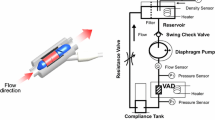Abstract
The influence of positioning and geometry of ventricular cannulas for contemporary continuous flow Left Ventricular Assist Devices (LVADs) was evaluated in a non-beating isolated heart preparation with borescopic visualization. Preload and LVAD flow were varied to evaluate degrees of ventricular decompression up to the point of ventricular collapse. The performance of a flanged cannula was compared to a conventional bevel-tipped cannula: quantitatively by the maximal flow attainable, and qualitatively by visualization of fluid tracer particles within the ventricular chamber. Three forms of ventricular suck-down occurred: concentric collapse, gradual entrainment and instantaneous entrainment. In some circumstances, unstable oscillations of the ventricle were observed prior to complete collapse. Under conditions of low preload, the flanged cannula demonstrated less positional sensitivity, provided greater flow, and exhibited fewer areas of stagnation than the beveled cannula. These observations warrant further consideration of a flanged ventricular cannula to mitigate complications encountered with conventional cannulae.







Similar content being viewed by others
References
Amin, D. V., et al. Induction of ventricular collapse by an axial flow blood pump. ASAIO J. 44(5):M685–M690, 1998.
Antaki, J. F., et al. An improved left ventricular cannula for chronic dynamic blood pump support. Artif. Organs 19(7):671–675, 1995.
Bachman, T. Development and evaluation of the quintessential ventricular cannula. In: Biomedical Engineering. Pittsburgh: University of Pittsburgh, 2003, p. 57.
Badiwala, M. V., H. J. Ross, and V. Rao. An unusual complication of support with a continuous-flow cardiac assist device. N. Engl. J. Med. 357(9):936–937, 2007.
Bhama, J. K., et al. Development of an ex vivo ovine ventricular assist device model for intraventricular visualization of the inflow cannula. J. Heart Lung Transplant. 28(8):860–861, 2009.
Choi, S., J. R. Boston, and J. F. Antaki. Hemodynamic controller for left ventricular assist device based on pulsatility ratio. Artif. Organs 31(2):114–125, 2007.
Curtis, A. A multiple modality study of the hemodynamics of left ventricular apical cannulations. In: Bioengineering. Pittsburgh: University of Pittsburgh, 1998.
Curtis, A. S., et al. Novel ventricular apical cannula: in vitro evaluation using transparent, compliant ventricular casts. ASAIO J. 44(5):M691–M695, 1998.
Drummond, A. Biomedical surgical planning for pediatric ventricular assist device (PVAD). In: Biomedical Engineering. Pittsburgh, 2008, p. 189
Ferreira, A., et al. A discriminant-analysis-based suction detection system for rotary blood pumps. Conf. Proc. IEEE Eng. Med. Biol. Soc. 1:5382–5385, 2006.
Griffith, B. P., et al. HeartMate II left ventricular assist system: from concept to first clinical use. Ann. Thorac. Surg. 71(3 Suppl):S116–S120, 2001; discussion S114–S116.
Miyake, Y., et al. Left ventricular mobile thrombus associated with ventricular assist device: diagnosis by transesophageal echocardiography. Circ. J. 68(4):383–384, 2004.
Reesink, K., et al. Suction due to left ventricular assist: implications for device control and management. Artif. Organs 31(7):542–549, 2007.
Vollkron, M., et al. Development of a suction detection system for axial blood pumps. Artif. Organs 28(8):709–716, 2004.
Votapka, T. V., et al. Left ventricular cannula obstruction in a patient with previous ventricular aneurysmectomy. Ann. Thorac. Surg. 58(4):1182–1184, 1994.
Watanabe, K., et al. Development of a flexible inflow cannula with titanium inflow tip for the NEDO biventricular assist device. ASAIO J. 50(4):381–386, 2004.
Acknowledgments
The authors would like to thank Arielle Drummond, PhD; and Fangjun Shu, PhD; for their assistance with the development of the isolated heart preparation. The Authors would also like to thank Harvey Borovetz, PhD for his support. Financial support was provided by an STTR Grant from the National Institute of Health 1R41HL082251-01.
Conflict of interest
At the time of the study, Josiah Verkaik was employed by LaunchPoint technologies, Inc. All remaining authors have no disclosures to report.
Author information
Authors and Affiliations
Corresponding author
Additional information
Associate Editor Keefe B. Manning oversaw the review of this article.
Electronic supplementary material
Below is the link to the electronic supplementary material.
Movie 1- Borescopic and transepicardial echocardiographic long-axis view of concentric ventricular collapse and resulting oscillation generated using aligned flared cannula. (MPG 11581 kb)
Movie 2- Borescopic view of instantaneous ventricular entrainment and resulting oscillation generated using misaligned flared cannula. (MPG 10705 kb)
Movie 3- Borescopic and transepicardial echocardiographic long-axis view of concentric ventricular collapse generated using aligned beveled cannula. (MPG 10705 kb)
Movie 4- Borescopic view of gradual ventricular entrainment and resulting oscillation generated using misaligned beveled cannula. Movie was recorded at 4x normal speed. (MPG 11429 kb)
Rights and permissions
About this article
Cite this article
Bachman, T.N., Bhama, J.K., Verkaik, J. et al. In Vitro Evaluation of Ventricular Cannulation for Rotodynamic Cardiac Assist Devices. Cardiovasc Eng Tech 2, 203–211 (2011). https://doi.org/10.1007/s13239-011-0050-x
Received:
Accepted:
Published:
Issue Date:
DOI: https://doi.org/10.1007/s13239-011-0050-x




